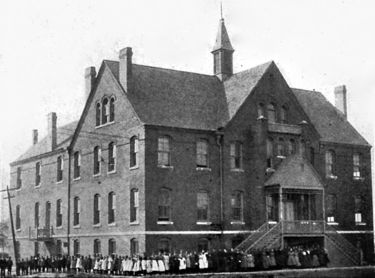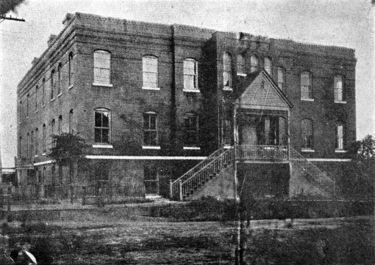St Mark's School: Difference between revisions
(Created page with "'''St Mark's School''' (originally '''St Mark's Industrial and Academic School for Colored Girls'''<!--http://digitalcollections.nypl.org/items/510d47df-b7d3-a3d9-e040-e00a180...") |
No edit summary |
||
| (5 intermediate revisions by 2 users not shown) | |||
| Line 1: | Line 1: | ||
'''St Mark's School''' (originally '''St Mark's Industrial and Academic School for Colored Girls''' | [[Image:St Mark's School.jpg|right|thumb|375px|St Mark's School in a 1909 publication]] | ||
[[File:1923 St Marks School.jpg|right|thumb|375px||St Mark's School in a 1923 publication]] | |||
'''St Mark's School''' (originally '''St Mark's Industrial and Academic School for Colored Girls''' and later '''St Mark's Academic and Industrial School''' was a private school founded in [[1891]] by the Protestant Episcopal [[St Mark's Episcopal Church]]. It was the first institution in [[Birmingham]] to offer secondary education to black students. It was established with financial support from [[Episcopal Church of the Advent]] deacon [[James Van Hoose]] and under the authority of Bishop [[Richard Wilmer]]. | |||
The | The parish began teaching a small group of eight students in 1891 with two female teachers, both white, who came to Birmingham from New York and Michigan. The school's large four-story brick building, completed in [[1892]], was located at [[18th Street South|18th Street]] and [[3rd Avenue South|Avenue C]] on [[Southside]]. The faculty was expanded, notably with the addition of lay-reader [[C. V. Augustine]]. | ||
The school was damaged by fire in [[1905]], but was rebuilt. | In [[1899]] [[Charles Brooks (minister)|Charles W. Brooks]] came to Birmingham from Baltimore, Maryland to serve as rector of [[St Mark's Episcopal Church]] and as principal of the school. High school grades were added under his leadership, and the school awarded its first high school diploma in [[1900]]. | ||
Although it charged a modest tuition, the school was funded primarily by the [[Episcopal Diocese of Alabama]], the Episcopal Board of Missions and the American Church Institute for Negroes. St Mark's originally only accepted female students, many of whom boarded at the school. | |||
The "industrial" department focused on teaching homemaking skills such as cooking, sewing and laundering, anticipating that female graduates seeking employment would normally find it as domestic servants. The school also taught religion classes, and its academic curriculum advanced to the high school level, including "the reading of two or more books of Caesar." It also offered instrumental and vocal music programs with an opportunity to participate in a glee club. Graduates of the high school often went on to [[Tuskegee University|Tuskegee Institute]] or other colleges. | |||
The school's three-story brick building was damaged by fire in [[1905]], but was rebuilt, except for the attic floor. By [[1911]] enrollment had grown to 358 students (of which 300 were girls) and eight teachers. All but 8 of the boys and 62 of the girls were in the elementary grades. By [[1914]] enrollment was reduced to 192, of which 171 were in the elementary grades, and the staff was seven strong. | |||
St Mark's School closed in [[1940]] following the establishment of Birmingham's public [[Parker High School|Industrial High School]]. | |||
==Notable graduates== | |||
* [[Mattie Lula Parham]], grandmother of [[Condoleezza Rice]] | |||
==References== | ==References== | ||
* Devigne, Sadie E. Beach (1907) "[http://hdl.handle.net/2027/uc1.b3793667?urlappend=%3Bseq=885 St. Mark's School, Birmingham, Alabama]" ''The Colored American''. Vol. 12-13 | * Devigne, Sadie E. Beach (1907) "[http://hdl.handle.net/2027/uc1.b3793667?urlappend=%3Bseq=885 St. Mark's School, Birmingham, Alabama]" ''The Colored American''. Vol. 12-13 | ||
* United States Bureau of Education (1912) ''Report of the Commissioner of Education Made to the Secretary of the Interior for the Year Ended June 30, 1911''. Washington D.C.: Government Printing Office. | |||
* {{Owen-1921}} | |||
* Smith, Barbara (1976) ''St Mark's Academic and Industrial School, 1892-1940''. Birmingham. privately printed. | |||
* {{Fallin-1997}} | |||
* Schnorrenberg, Barbara Brandon (December 2002) "[http://www.jstor.org/stable/42615917 The Best School for Blacks in the State" St. Mark's Academic and Industrial School Birmingham, Alabama 1892-1940]" ''Anglican and Episcopal History'' Vol. 71, No. 4, pp. 519-549 | * Schnorrenberg, Barbara Brandon (December 2002) "[http://www.jstor.org/stable/42615917 The Best School for Blacks in the State" St. Mark's Academic and Industrial School Birmingham, Alabama 1892-1940]" ''Anglican and Episcopal History'' Vol. 71, No. 4, pp. 519-549 | ||
[[Category: | [[Category:1891 establishments]] | ||
[[Category:1940 disestablishments]] | [[Category:1940 disestablishments]] | ||
[[Category:1893 buildings]] | [[Category:1893 buildings]] | ||
[[Category:18th Street South]] | [[Category:18th Street South]] | ||
[[Category:3rd Avenue South]] | [[Category:3rd Avenue South]] | ||
[[Category:Block 150]] | |||
[[Category:Private schools]] | [[Category:Private schools]] | ||
[[Category: | [[Category:Former high schools]] | ||
[[Category:Christian schools]] | |||
[[Category:Demolished buildings]] | |||
[[Category:Episcopal Diocese of Alabama]] | |||
Latest revision as of 09:28, 8 October 2022
St Mark's School (originally St Mark's Industrial and Academic School for Colored Girls and later St Mark's Academic and Industrial School was a private school founded in 1891 by the Protestant Episcopal St Mark's Episcopal Church. It was the first institution in Birmingham to offer secondary education to black students. It was established with financial support from Episcopal Church of the Advent deacon James Van Hoose and under the authority of Bishop Richard Wilmer.
The parish began teaching a small group of eight students in 1891 with two female teachers, both white, who came to Birmingham from New York and Michigan. The school's large four-story brick building, completed in 1892, was located at 18th Street and Avenue C on Southside. The faculty was expanded, notably with the addition of lay-reader C. V. Augustine.
In 1899 Charles W. Brooks came to Birmingham from Baltimore, Maryland to serve as rector of St Mark's Episcopal Church and as principal of the school. High school grades were added under his leadership, and the school awarded its first high school diploma in 1900.
Although it charged a modest tuition, the school was funded primarily by the Episcopal Diocese of Alabama, the Episcopal Board of Missions and the American Church Institute for Negroes. St Mark's originally only accepted female students, many of whom boarded at the school.
The "industrial" department focused on teaching homemaking skills such as cooking, sewing and laundering, anticipating that female graduates seeking employment would normally find it as domestic servants. The school also taught religion classes, and its academic curriculum advanced to the high school level, including "the reading of two or more books of Caesar." It also offered instrumental and vocal music programs with an opportunity to participate in a glee club. Graduates of the high school often went on to Tuskegee Institute or other colleges.
The school's three-story brick building was damaged by fire in 1905, but was rebuilt, except for the attic floor. By 1911 enrollment had grown to 358 students (of which 300 were girls) and eight teachers. All but 8 of the boys and 62 of the girls were in the elementary grades. By 1914 enrollment was reduced to 192, of which 171 were in the elementary grades, and the staff was seven strong.
St Mark's School closed in 1940 following the establishment of Birmingham's public Industrial High School.
Notable graduates
- Mattie Lula Parham, grandmother of Condoleezza Rice
References
- Devigne, Sadie E. Beach (1907) "St. Mark's School, Birmingham, Alabama" The Colored American. Vol. 12-13
- United States Bureau of Education (1912) Report of the Commissioner of Education Made to the Secretary of the Interior for the Year Ended June 30, 1911. Washington D.C.: Government Printing Office.
- Owen, Thomas McAdory and Marie Bankhead Owen (1921) History of Alabama and Dictionary of Alabama Biography. 4 volumes. Chicago, Illinois: S. J. Clarke Publishing Co.
- Smith, Barbara (1976) St Mark's Academic and Industrial School, 1892-1940. Birmingham. privately printed.
- Fallin, Wilson (1997) The African American Church in Birmingham, Alabama, 1815-1963: A Shelter in the Storm. Taylor & Francis ISBN 9780815328834
- Schnorrenberg, Barbara Brandon (December 2002) "The Best School for Blacks in the State" St. Mark's Academic and Industrial School Birmingham, Alabama 1892-1940" Anglican and Episcopal History Vol. 71, No. 4, pp. 519-549

